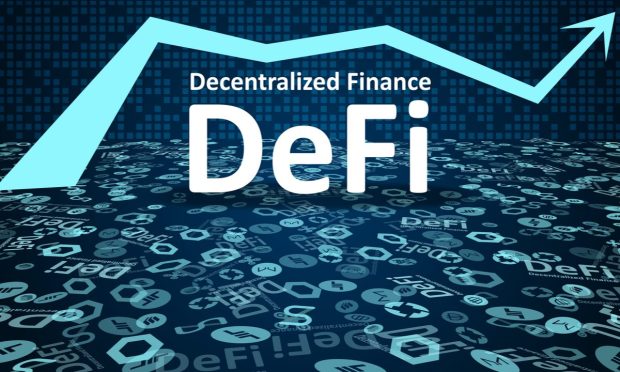DeFi Is the New Big Thing in Crypto. But What Is It? Here’s Everything You Need to Know

Decentralized finance is at the core of the crypto revolution. Or so the hype says.
In the year in which the world woke up to the reality of cryptocurrency as something other than a combination of techie plaything and tool of criminals, DeFi stood out.
With $100 billion invested, it’s far too large for mainstream finance to ignore. DeFi is, in many ways, cryptocurrency at its purist: A financial tool that needs neither banker nor bank, neither broker nor brokerage.
It is a wholly peer-to-peer way of doing what the financial institutions have been doing for centuries — providing a source of trust — without having to pay the tithe demanded by a trusted third party.
This is why it has gained so much attention. But theory is generally messier than fact, and that is certainly the case with DeFi.
Decentralized exchanges (DEXs) can offer trades and derivatives cheaper and faster than even “centralized” crypto. And the lending and borrowing platforms can provide both the lenders and the borrowers far better rates than any bank.
However, like any financial offering, DeFi comes with risks: The same old frauds and the new technological wrinkles of a technology with no corrections or do-overs. And there are also new products to understand: yield farming and liquidity pools, for example.
Over the course of these 10 articles, we’ll break all of this down in clear, coherent language for people new to crypto and DeFi alike. At the end, you’ll have a solid, basic understanding of how DeFi works, what the risks and potential rewards are, and what people are talking about when they sing its praises. You’ll know how to separate the hyped-up chaff from the investable wheat.
What is DeFi
DeFi is red hot. It is the most promising — and problematic — part of cryptocurrency FinTech. It is a $100 billion juggernaut that “anyone” says will be the downfall of big finance, replacing commission-hungry bankers with lean, mean smart contracts that let DeFi projects run without any central authority at all. The hype says DeFi is capitalism at its purest. The end of Wall Street. The cynic says, “Let’s look under the hood.”
See here: What Is DeFi?
What Are the Top DeFi Platforms?
DeFi is the most rewarding and riskiest part of the blockchain revolution, which perhaps explains why $3.7 billion has been invested in a project with a name like “SushiSwap.” The number of DeFi projects is growing exponentially and bringing a lot of fraud and failure along with its success. Here’s a look at some of the biggest and most prosperous.
See here: What Are the Top DeFi Platforms?
What Is a Smart Contract?
Smart contracts are the building blocks of DeFi. Of course, that’s true of any blockchain project that isn’t a pure cash replacement, from NFTs to supply chain management tools. The self-executing contracts are immutable. Once agreed to and the funds locked in, the contract will be paid without the need for a trusted intermediary and cannot be changed or canceled. Smart contracts can be complex enough to build decentralized apps and dumb enough to do what you said, not what you meant — caveat emptor given form.
See here: What Is a Smart Contract?
What is Yield Farming and Liquidity Mining?
Yield farming and liquidity mining are the ways of putting your crypto to work for you. DeFi lending platforms and DEXs use liquidity pools to make loans and trades rather than matching a borrower with a lender or buyer with the seller. Crypto locked into these pools earns interest and fees. There are a lot of variations on this simple theme, some far more complex and lucrative — or damaging.
See here: What is Yield Farming and Liquidity Mining?
What is Staking?
Staking is the new mining, a way of validating transactions and adding them to a blockchain that is far faster and more energy efficient than slow, polluting Bitcoin. Far more scalable than mining, staking is what’s needed to let blockchain compete with the likes of Visa as a transaction processor. It’s also a good way to earn passive income with your crypto.
See here: What is Staking?
The Top 10 Uses of DeFi
What is DeFi good for? Well, there are a lot of uses starting with decentralized exchanges and lending platforms. Aside from trading and borrowing with human interference, DeFi is a good way of making derivative contracts, building marketplaces and can be used in gaming and metaverse worlds, among other things.
See here: What Are DeFi’s Top 10 Uses?
Governing the Ungoverned: Unpacking DeFi and DAO
DeFi platforms run without any central control or human interference. So how do you make changes — say fix a bug, change an interest rate, or add a cryptocurrency trading pair? By voting, of course. Thus the decentralized autonomous organization, or DAO, which is a smart contract controlled governance system.
See here: Unpacking DeFi and DAO
DeFi’s Very Real Risks
The idea of DeFi is that there is no central control at all – no human interference, no trusted third party of any kind. So what do you do when something goes wrong, from fraud to an expensive typo in a hastily written smart contract? Nothing. And that’s not the worst of the risks — fraud, market manipulation, frequent and fast margin calls. DeFi has plenty of risks.
See here: DeFi’s Very Real Risks
What Are the Top DeFi Blockchains?
DeFi is built on Ethereum, and Ethereum can’t handle its success. The No. 2 blockchain has gotten jammed by the number of transactions DeFi is sending it, making it slow and transaction fees sky high. So what do you do? Build a better blockchain. Here are some of the leading candidates to be Ethereum Killers — a nickname that’s perhaps overambitious but gives a sense of the goal: stealing its projects.
See here: What Are the Top DeFi Blockchains?
DeFi: What’s Hype, What’s Real, and What Matters
We’ve gone through the whats and the hows of DeFi, so it’s time to step back and take a look at its reality. There’s a lot of hype, but there’s also a lot of value and opportunity. Here’s a look back.
See here: What’s Real, What’s Hype, What Matters
